Abstract
In a consecutive series of nearly 20,000 freshly delivered placentas, 2 vessels instead of the normal 3 were found in the umbilical cords of 143 (0·72%) infants, 83 females and 60 males. 4 infants were twins: in each instance the co-twin had 3 vessels. The incidence of single umbilical artery (SUA) in multiple pregnancies was slightly less than in singletons. 2 infants with SUA were sibs.
There was an increased incidence of major malformations (17·5%), of prematurity (16·5%), and of smallness for dates (34%) among infants with SUA. 25 (17·5%) infants, of whom 19 had a major malformation, died in the perinatal period; of these, 2 had a persistent vitelline artery. (A follow-up study has been carried out on the surviving infants—results to be published.)
This investigation into the incidence and significance of SUA is based on what is so far the largest prospective and unselected series collected in a single maternity unit. All placental examinations and necropsies were carried out by one pathologist, all follow-up examinations by one paediatrician.
Full text
PDF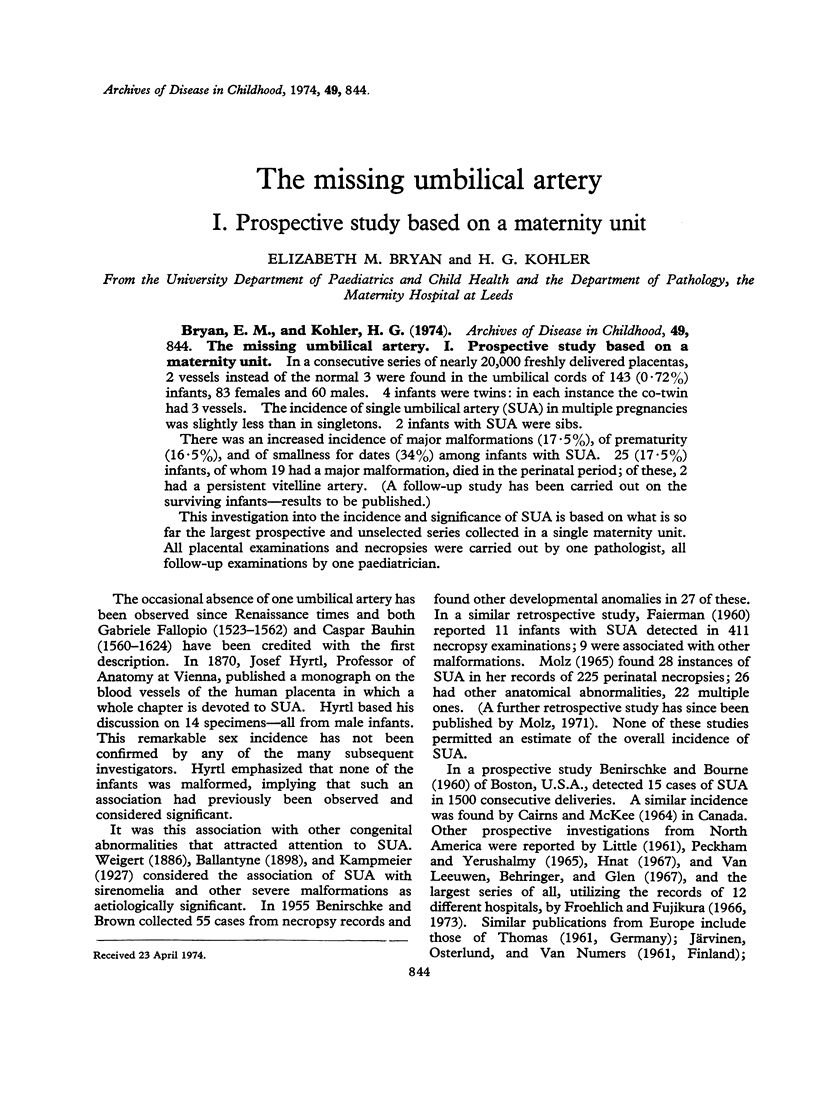
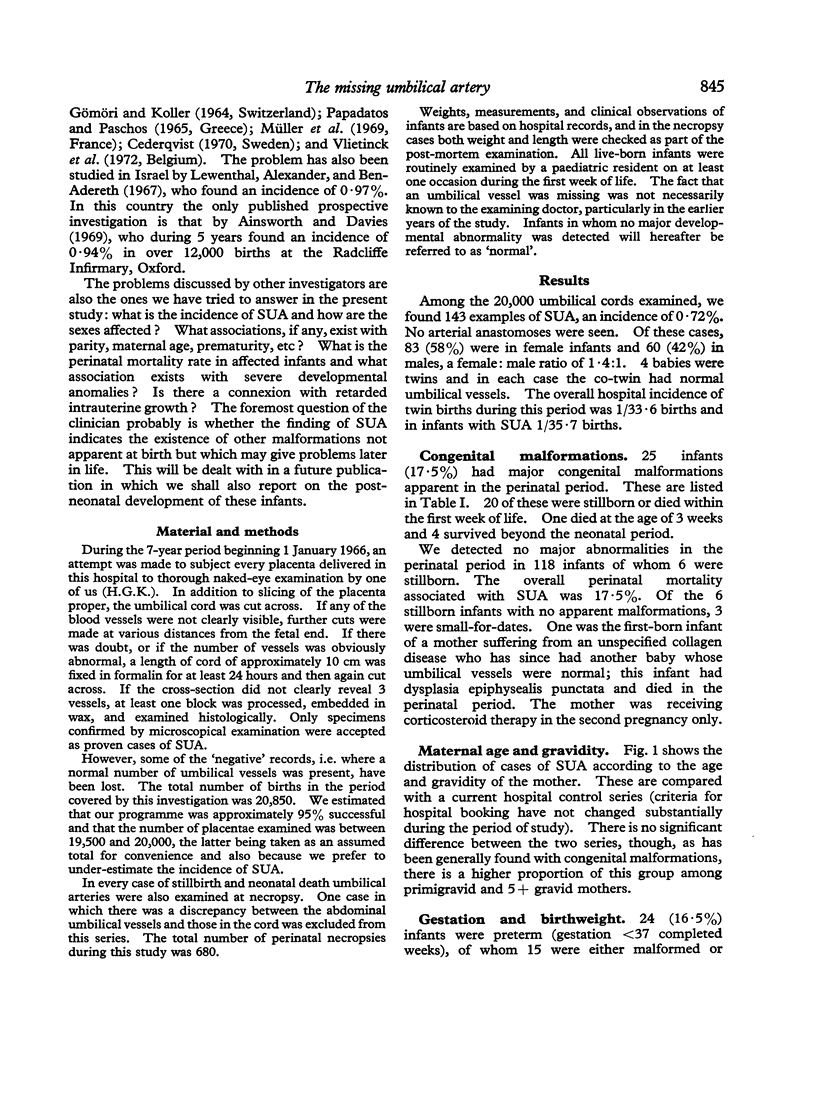

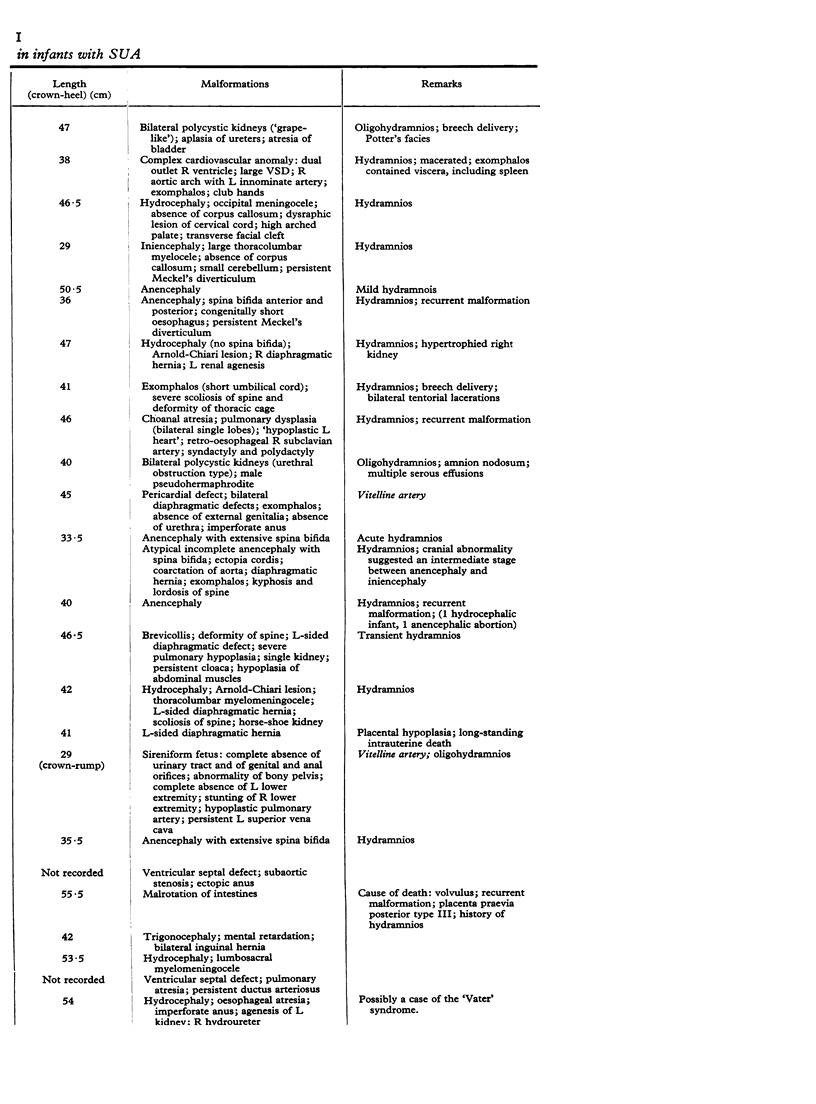

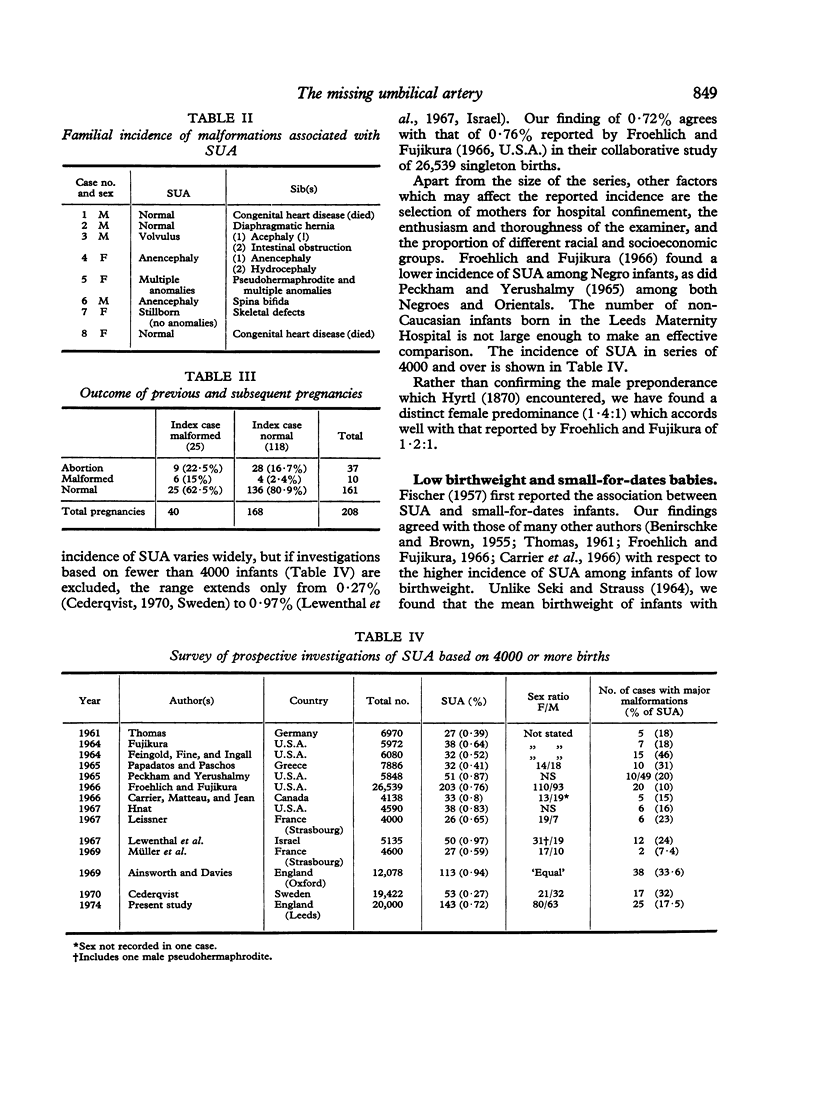
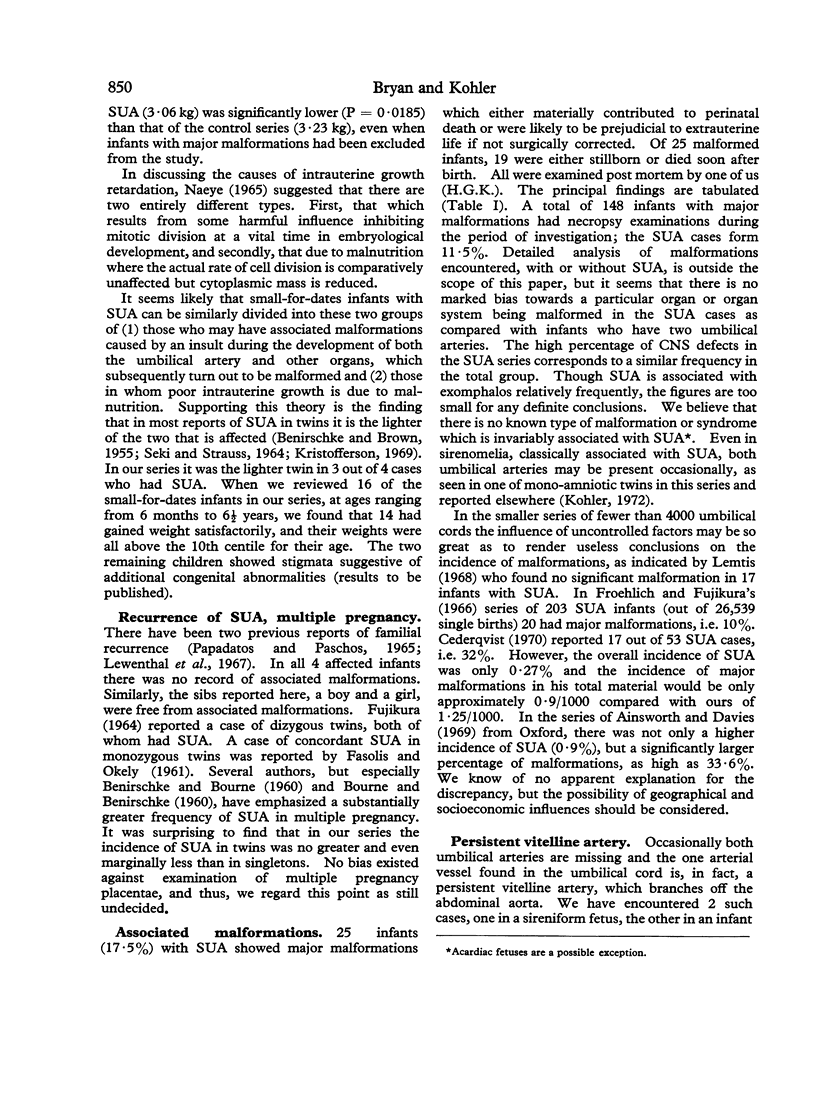
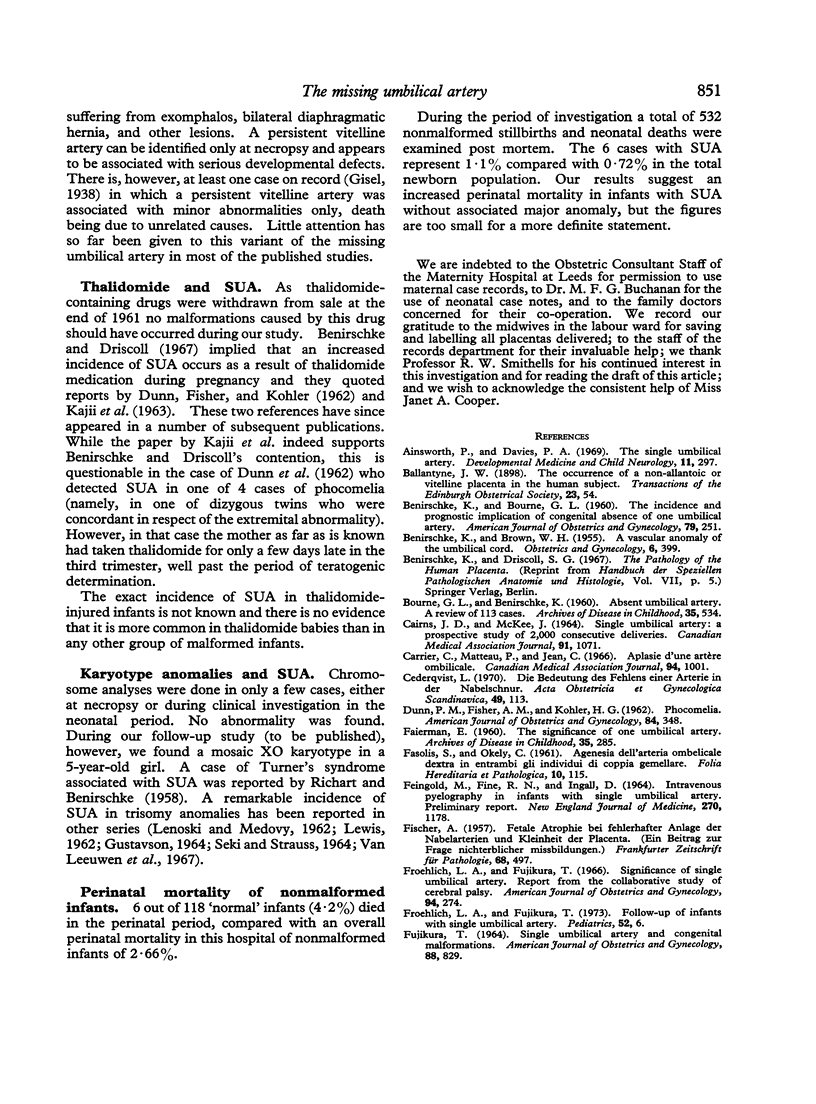
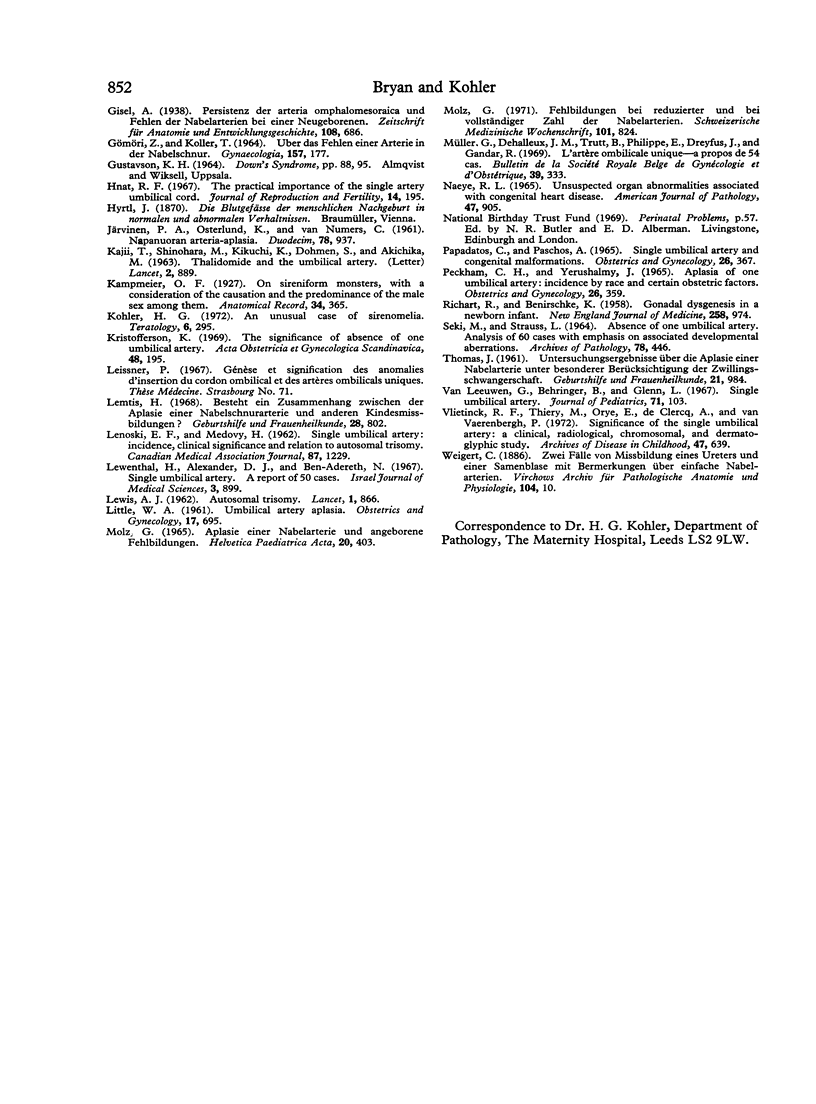
Selected References
These references are in PubMed. This may not be the complete list of references from this article.
- Ainsworth P., Davies P. A. The single umbilical artery: a five-year survey. Dev Med Child Neurol. 1969 Jun;11(3):297–302. doi: 10.1111/j.1469-8749.1969.tb01436.x. [DOI] [PubMed] [Google Scholar]
- BENIRSCHKE K., BOURNE G. L. The incidence and prognostic implication of congenital absence of one umbilical artery. Am J Obstet Gynecol. 1960 Feb;79:251–254. doi: 10.1016/0002-9378(60)90183-6. [DOI] [PubMed] [Google Scholar]
- BENIRSCHKE K., BROWN W. H. A vascular anomaly of the umbilical cord; the absence of one umbilical artery in the umbilical cords of normal and abnormal fetuses. Obstet Gynecol. 1955 Oct;6(4):399–404. [PubMed] [Google Scholar]
- CAIRNS J. D., MCKEE J. SINGLE UMBILICAL ARTERY: A PROSPECTIVE STUDY OF 2000 CONSECUTIVE DELIVERIES. Can Med Assoc J. 1964 Nov 14;91:1071–1073. [PMC free article] [PubMed] [Google Scholar]
- Carrier C., Matteau P., Jean C. Aplasie d'une artère ombilicale. Can Med Assoc J. 1966 May 7;94(19):1001–1004. [PMC free article] [PubMed] [Google Scholar]
- Cederqvist L. Die Bedeutung des Fehlens einer Arterie in der Nabelschnur--eine prospektive endemiologische Studie. Acta Obstet Gynecol Scand. 1970;49(1):113–117. doi: 10.3109/00016347009157525. [DOI] [PubMed] [Google Scholar]
- DUNN P. M., FISHER A. M., KOHLER H. G. Phocomelia. Am J Obstet Gynecol. 1962 Aug 1;84:348–355. doi: 10.1016/0002-9378(62)90131-x. [DOI] [PubMed] [Google Scholar]
- FAIERMAN E. The significance of one umbilical artery. Arch Dis Child. 1960 Jun;35:285–288. doi: 10.1136/adc.35.181.285. [DOI] [PMC free article] [PubMed] [Google Scholar]
- FEINGOLD M., FINE R. N., INGALL D. INTRAVENOUS PYELOGRAPHY IN INFANTS WITH SINGLE UMBILICAL ARTERY. A PRELIMINARY REPORT. N Engl J Med. 1964 May 28;270:1178–1180. doi: 10.1056/NEJM196405282702208. [DOI] [PubMed] [Google Scholar]
- FISCHER A. Fetale Atrophie bei fehlerhafter Anlage der Nabelarterien und Kleinbeit der Placenta; ein Beitrag zur Frage nichterblicher Missbildungen. Frankf Z Pathol. 1957;68(4):497–506. [PubMed] [Google Scholar]
- Froehlich L. A., Fujikura T. Follow-up of infants with single umbilical artery. Pediatrics. 1973 Jul;52(1):6–13. [PubMed] [Google Scholar]
- Froehlich L. A., Fujikura T. Significance of a single umbilical artery. Report from the collaborative study of cerebral palsy. Am J Obstet Gynecol. 1966 Jan 15;94(2):274–279. doi: 10.1016/0002-9378(66)90476-5. [DOI] [PubMed] [Google Scholar]
- GOEMOERI Z., KOLLER T., Jr UBER DAS FEHLEN EINER ARTERIE IN DER NABELSCHNUR. Gynaecologia. 1964;157:177–190. [PubMed] [Google Scholar]
- Hnat R. F. The practical importance of the single artery umbilical cord. J Reprod Fertil. 1967 Oct;14(2):195–201. doi: 10.1530/jrf.0.0140195. [DOI] [PubMed] [Google Scholar]
- JARVINEN P. A., OSTERLUND K., v NUMBERS [Umbilical artery aplasia]. Duodecim. 1963;78:937–940. [PubMed] [Google Scholar]
- Kohler H. G. An unusual case of sirenomelia. Teratology. 1972 Dec;6(3):295–301. doi: 10.1002/tera.1420060307. [DOI] [PubMed] [Google Scholar]
- Kristoffersen K. The significance of absence of one umbilical artery. Acta Obstet Gynecol Scand. 1969;48(2):195–214. doi: 10.3109/00016346909156638. [DOI] [PubMed] [Google Scholar]
- LENOSKI E. F., MEDOVY H. Single umbilical artery: incidence, clinical significance and relation to autosomal trisomy. Can Med Assoc J. 1962 Dec 8;87:1229–1231. [PMC free article] [PubMed] [Google Scholar]
- LITTLE W. A. Umbilical artery aplasia. Obstet Gynecol. 1961 Jun;17:695–700. [PubMed] [Google Scholar]
- Lemtis H. Besteht ein Zusammenhang zwischen der Aplasie einer Nabelschnurarterie und anderen Kindesmissbildungen. Geburtshilfe Frauenheilkd. 1968 Aug;28(8):802–805. [PubMed] [Google Scholar]
- Lewenthal H., Alexander D. J., Ben-Adereth N. Single umbilical artery. A report of 50 cases. Isr J Med Sci. 1967 Nov-Dec;3(6):899–902. [PubMed] [Google Scholar]
- Molz G. Aplasie einer Nabelarterie und angeborene Fehlbildungen. Helv Paediatr Acta. 1965 Sep;20(4):403–414. [PubMed] [Google Scholar]
- Molz G. Fehlbildungen bei reduzierter und bei vollständiger Zahl der nabelarterien. Obduktionsbefunde bei 955 Reif-, oder Mangelgebornen. Schweiz Med Wochenschr. 1971 Jun 5;101(22):824–827. [PubMed] [Google Scholar]
- Muller G., Dehalleux J. M., Trutt B., Philippe E., Dreyfus J., Gandar R. L'artère ombilicale unique: a propos de 54 cas. Bull Soc R Belge Gynecol Obstet. 1969 Jul-Aug;39(4):333–347. [PubMed] [Google Scholar]
- Naeye R. L. Unsuspected organ abnormalities associated with congenital heart disease. Am J Pathol. 1965 Nov;47(5):905–915. [PMC free article] [PubMed] [Google Scholar]
- PAPADATOS C., PASCHOS A. SINGLE UMBILICAL ARTERY AND CONGENITAL MALFORMATIONS. Obstet Gynecol. 1965 Sep;26:367–370. [PubMed] [Google Scholar]
- PECKHAM C. H., YERUSHALMY J. APLASIA OF ONE UMBILICAL ARTERY: INCIDENCE BY RACE AND CERTAIN OBSTETRIC FACTORS. Obstet Gynecol. 1965 Sep;26:359–366. [PubMed] [Google Scholar]
- RICHART R., BENIRSCHKE K. Gonadal dysgenesis in a newborn infant. N Engl J Med. 1958 May 15;258(20):974–978. doi: 10.1056/NEJM195805152582002. [DOI] [PubMed] [Google Scholar]
- SEKI M., STRAUSS L. ABSENCE OF ONE UMBILICAL ARTERY. ANALYSIS OF 60 CASES WITH EMPHASIS ON ASSOCIATED DEVELOPMENTAL ABERRATIONS. Arch Pathol. 1964 Oct;78:446–453. [PubMed] [Google Scholar]
- VanLeeuwen G., Behringer B., Glenn L. Single umbilical artery. J Pediatr. 1967 Jul;71(1):103–106. doi: 10.1016/s0022-3476(67)80237-3. [DOI] [PubMed] [Google Scholar]
- Vlietinck R. F., Thiery M., Orye E., De Clercq A., Van Vaerenbergh P. Significance of the single umbilical artery. A clinical, radiological, chromosomal, and dermatoglyphic study. Arch Dis Child. 1972 Aug;47(254):639–642. doi: 10.1136/adc.47.254.639. [DOI] [PMC free article] [PubMed] [Google Scholar]


